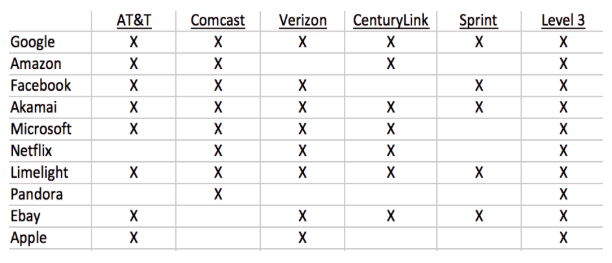
The network interconnection deals between content providers and ISPs are often shrouded in secrecy, at least when it comes to the question of whether any money is changing hands. But it’s possible to figure out which companies are directly exchanging traffic with ISPs by examining publicly available information if you know where to search.
Analyst Dan Rayburn today published a blog post and chart that shows which ISPs the likes of Google, Amazon, Facebook, Microsoft, Netflix, Pandora, eBay, and Apple have direct connections with. Take a look:

The connections are “public information that anyone can look up simply by knowing the networks’ Autonomous System number (AS) and looking at their peers,” Rayburn wrote. “You don’t have to be a networking engineer to look at BGP [Border Gateway Protocol] relationships and see what is taking place. It’s all public info.”
Numerous sites provide the information, but Rayburn said he likes Hurricane Electric’s Looking Glass the best.
We can’t tell from the public data which Web companies are paying ISPs for these connections. The traditional “Tier 1” networks that historically make up the Internet’s backbone—including AT&T, CenturyLink, Verizon, Sprint, and Level 3—have generally exchanged traffic with each other without payment in what’s known as settlement-free peering.
Content companies sometimes pay ISPs for direct connections, but this practice has been controversial of late. Netflix, which accounts for about a third of peak Internet traffic in North America, has secured free connections to some ISPs. But Comcast and Verizon asked Netflix to pay, which the company did under protest. Netflix still lacks a direct link to AT&T, and congestion between the two has led to poor video quality.
Apple recently built a content delivery network to distribute its own data, and according to Rayburn, the company is negotiating paid interconnection deals with ISPs.
As you can see from the chart, Comcast still lacks direct links to eBay and Apple, while Verizon lacks direct connections to Amazon and Pandora.
Content companies generally pay someone to distribute their traffic, but there could be free connections at some point in the chain between the content service and consumers. For example, a Web service could buy transit from a Tier 1 network, which then exchanges traffic with ISPs, often without any money changing hands. In other cases, a Web company might pay a third-party content delivery network like Akamai, which then pays ISPs for direct connections.
Tier 1 networks Cogent and Level 3 have complained about ISPs demanding payments and have asked the FCC to investigate.
[ Source :- Arstechnica ]







